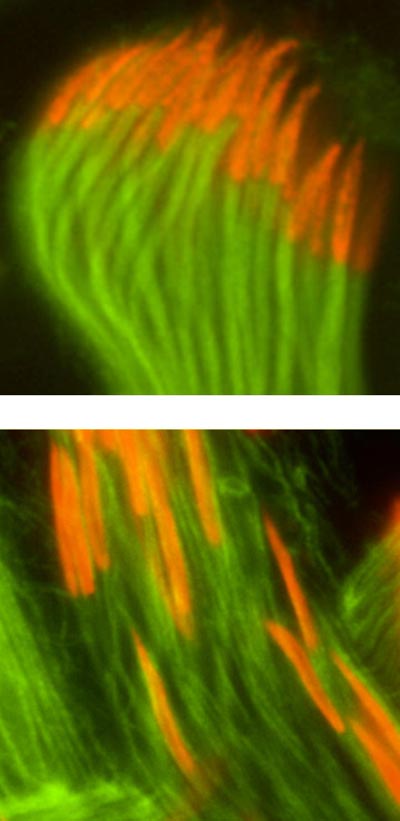Key protein in sperm tail assembly identified

Top: Normal Drosophila melanogaster spermatozoa. Orange shows heads and green shows tails. Bottom: Mutant Drosophila melanogaster spermatozoa. The heads are severed from the tail ends and are dispersed. Photo courtesy of S. Llamazares / Gonzalez Lab
In flies, as in humans, the sperm cell (spermatozoon) is made up of the cell body proper, also referred to as the sperm “head”, and the flagellum. The flagellum, also called the sperm “tail”, is a slender lash-like appendage that protrudes from the cell body.
By beating their tails, sperm cells swim to the female reproductive cell (oocyte) and fertilise it. A bundle of microtubules that span the entire length of the tail is critical for flagellar beating.
These microtubules are arranged in a characteristic radial symmetry that has been conserved throughout evolution and is templated by a small organelle called the basal body, which sits at the base of the flagellum.
Using the vinegar fly Drosophila melanogaster as a model to study how the sperm tail develops, Gonzalez's Cell Division Lab has found that CENTROBIN plays a critical role in the assembly of a subset of microtubules within basal bodies. In the absence of CENTROBIN, basal bodies lack these microtubules, as do the non-motile tails that they template. Consequently, CENTROBIN mutant males are sterile.
A human condition: “easily decapitated spermatozoa defect'
In addition to the faulty microtubule array within the tail, the head-to-tail link is often severed in CENTROBIN mutant sperm. This effect is reminiscent of a human male sterility condition known as the “easily decapitated spermatozoa defect'. Semen from individuals affected by this condition appears normal, but minimal micro-manipulation, such as that required for in vitro fertilisation, results in sperm heads that are separated from their tails and thus that cannot swim.
In summary, the recent article demonstrates that CENTROBIN, which is well conserved between humans and flies, is a positive regulator of normal flagellum development. Remarkably, a previous study by the same group showed that CENTROBIN exerts a negative effect in the development of primary cilia.
Primary cilia are a shorter version of flagella that are present in certain neurons in the fly and in many cell types in humans, where they function as sensors of external stimuli. Like flagella, primary cilia contain a microtubule array that is templated by the basal body.
Taken together, these results reveal the multifunctional nature of CENTROBIN, a protein that plays opposing roles in distinct cell types in the same organism.
###
Reference article:
Jose Reina, Marco Gottardo, Maria G. Riparbelli, Salud Llamazares, Giuliano Callaini, Cayetano Gonzalez
Centrobin is essential for C-tubule assembly and flagellum development in Drosophila melanogaster spermatogenesis
The Journal of Cell Biology (2018) DOI: 10.1083/jcb.201801032
Media Contact
All latest news from the category: Life Sciences and Chemistry
Articles and reports from the Life Sciences and chemistry area deal with applied and basic research into modern biology, chemistry and human medicine.
Valuable information can be found on a range of life sciences fields including bacteriology, biochemistry, bionics, bioinformatics, biophysics, biotechnology, genetics, geobotany, human biology, marine biology, microbiology, molecular biology, cellular biology, zoology, bioinorganic chemistry, microchemistry and environmental chemistry.
Newest articles

Innovative vortex beam technology
…unleashes ultra-secure, high-capacity data transmission. Scientists have developed a breakthrough optical technology that could dramatically enhance the capacity and security of data transmission (Fig. 1). By utilizing a new type…

Tiny dancers: Scientists synchronise bacterial motion
Researchers at TU Delft have discovered that E. coli bacteria can synchronise their movements, creating order in seemingly random biological systems. By trapping individual bacteria in micro-engineered circular cavities and…

Primary investigation on ram-rotor detonation engine
Detonation is a supersonic combustion wave, characterized by a shock wave driven by the energy release from closely coupled chemical reactions. It is a typical form of pressure gain combustion,…



